With “Dance workshop Afrotrap” and the performance “Un truc d’ouf” hosted at Ballhaus Ost, performance collective La Fleur asks questions about the mixed identities of Europeans of African descent.
La Fleur is a collective of “urban style dancers, DJs, actors, and showbiz stars” founded in late 2016 by Monika Gintersdorfer and Franck Edmond Yao. Although most of the performers live in Paris, all of them have African roots – some of them are the children of immigrants, while others are first-generation migrants from Africa, for the most part from Côte d’Ivoire. Coupé-Décalé is the focal point of the collective’s wide-ranging influences in Afro-dance and music. This popular Ivorian dance music genre was created in 2002 by a group of Ivorian DJs in Paris, and is a fusion of African and electronic music and dance styles. Since its emergence, Coupé-Décalé has developed and spread not only across francophone Africa, but also within Europe and elsewhere. The following text is a contemplation on my very first encounter with this movement through an hour of conversation with Gintersdorfer, my participation in a two-and-a-half hour Afro-dance workshop led by three members of La Fleur, and the two-hour performance “Un truc d’ouf.”
First of all, I would like to contextualise the political significance of the merging between African and European influences in Coupé-Décalé, and the wild popularity it has gained in recent years across Europe. As Gintersdorfer said in the workshop, although Congolese music has been at the heart of the African music scene for a long time – and therefore many famous Congolese musicians have performed in major European cities, such as Brussels and Paris – European audiences have shown little interest in it. “Only the Africans who live there went to the concerts,” said Gintersdorfer. In contrast, Afrotrap music gained instant and enduring popularity across Europe from the moment of its conception in 2016. According to famous musician MHD, the ‘prince of Afrotrap’, the musical style has its roots in Coupé-Décalé. MHD is Senegalese-Guinean-French and his music represents countless first and second-generation immigrants of African origin living in Europe. Many face financial and social difficulties, working low-wage jobs (MHD himself was a pizza delivery man), and dealing with racism on a daily basis. Numerous young people from these communities who have so-called “hyphenated identities” – they are not simply “French,” but rather “Ivorian-French,” “Congolese-French”, and so on – seek to escape the struggles of their everyday lives by acquiring fame through music and dance. MHD’s music has not only created visibility for these lives, but also celebrated them.
On-stage during “Un truc d’ouf”, Yao describes this young generation with “hyphenated identities” who achieve success through music and dance as “the handsome youth” (in German Der hübsche Junge). At one point during his solo, he tells us that when nationalists see “these black people getting fame, earning a lot of money and going around in expensive cars, it almost gives them a heart attack.” As he aggressively clambers over audience members, invading their private space, he continues to say how this “handsome youth” gets to know the nationalists’ sons and daughters, becoming their friends and lovers. “This is the real mixture,” he says.
In another solo, Pheno Ambro speaks about an interview with MHD in which the musician explains that Afrotrap is not only a blend of two musical genres, Afro and Trap, but, more importantly, a mélange of two kinds of audiences. Once he has told us about this, all 10 performers walk into the seating area to join us, spreading themselves out among the predominantly white audience. “In every one of MHD’s concerts,” says Pheno Ambro, “there are always two different kinds of crowd – just like there is here today. And that’s beautiful to see.” This is a moment of shift. I am acutely aware of the fact that the workshop participants were mainly white, and that the audience of the performance is almost exclusively so. This awareness makes me feel slightly uncomfortable, involuntarily caught up in the dynamic of white viewers observing “exotic others.” When the performers sit with us, however, creating a more diverse audience, I feel this gap shrink.
Despite this general discomfort, I find it extremely pleasurable to watch the performers dance so gracefully and energetically to the music. At one point, while Yao is dancing, he tells us that a journalist once said that black people dancing is a cliché, even though they dance so beautifully. Yao questions whether their profession can be seen as a cliché. He says that he will continue dancing anyway and an audience member pleads, “Bitte!”. I shift in my seat in discomfiture at the overlap in my mind with other situations when white audiences have enjoyed “black entertainers” perform.

“Un truc d’ouf”, La Fleur ©Monika Gintersdorfer
This bitter sensation of voyeurism intensifies as Annick Choco explains a basic movement in Congolese dance – the kidney rotation – while all the other performers demonstrate this movement with her. I hear uneasy giggling from the audience. The reason for this is, I presume, the fact that the kidney rotation can look very sexualised to the white viewer. We watch as the 10 performers fluidly rotate their pelvic area in an infinite loop, their legs open, and their knees bent. Annick Choco explains that every Congolese kid learns this movement. “This is a part of Congolese identity,” she says, “You can learn it too, but it’s not easy.” I remember the moment in the workshop when Yao informed us that it was our kidneys that were rotating as he smoothly circled his pelvic area. I saw some eyes rolling, and later, a woman said, “Uh… excuse me? You sing to the kidneys?”. When we tried to imitate him, the move felt very specific and almost impossible. Feeling an odd tension in the room while we watch the performers circle their pelvic area with supple finesse, it crosses my mind that even though this is a totally natural movement for Congolese people, could it be that white people often sexualise it simply because it is “unusual” to them? I ponder what the exact nature of this “unusualness” is, and why it makes the white audience so uncomfortable, and think of Lillian Faderman’s insightful analysis in her book, Odd Girls and Twilight Lovers. A History of Lesbian Life in Twentieth-Century America. She explains the phenomenon of white homosexuals living in NYC in the early 1920s who travelled to Harlem in order to explore their sexuality:
Harlem had a particular appeal for whites who wanted to indulge in rebel sexuality. Perhaps there was a certain racism in their willingness to think of Harlem as a free-for-all party or, as Colliers Magazine said in the 1920s, “a synonym for naughtiness.” White fascination with Harlem seems to have smacked of a “sexual colonialism,” in which many whites used Harlem as a community, a stimulant to sexuality. And as in many colonized countries, Harlem itself, needing to encourage tourism for economic reasons, seemed to welcome the party atmosphere. . . . Made braver by bootlegged liquor, jazz, and what they saw as the primitive excitement of Africa, they acted out their enchantment with the primal and the erotic. They were fascinated with putative black naturalness and exoticism, and they romantically felt that those they regarded as the “lower class” had something to teach them about sexual expression that their middle-class milieu had kept from them. They believed Harlem gave them permission – or they simply took permission there – to explore what was forbidden in the white world.
So, I ask myself, what here is forbidden to the white world? I remember what Gintersdorfer said about “some European men” during the workshop, and how they refuse to move their pelvises because they find it obscene and unmanly. “This kind of thought never enters the heads of Congolese men!” she exclaimed. It seemed clear to me at the time that those immersed in the white cultural milieu attribute negative connotations to gestures that appear feminine to them, such as moving the pelvis. Performing such a movement, especially for male-identifying humans in the white world, therefore indicates a shameful feebleness, which then threatens their position of power. As a consequence, witnessing this movement carried out by other male-presenting bodies makes the “other” not only “lower” (performing the “bottom” sexual role), but also “erotic.” Being able to break this taboo as a white person, as described in Faderman’s text, was considered thus an act of rebellion. This looks to me like just another consequence of the prevalence of normalisation around white cultural standards and the subsequent stereotypical exoticism of “The Other.” As an Asian woman living in Germany, I think of how often semi-strangers come up and tell me “I know you’re polite and calm,” projecting onto me a common stereotyping of ‘The East.’
In the next part of the performance, when I watch the performers try, one by one, to do “something they have not learned before”, I am thrown into immediate confusion. Based on my conversation with Gintersdorfer, I understand this section as a way of showing openness to accepting and merging a wide range of styles of movement. By attempting things that the performers have never done before, she explained, they try to find “a new mixture.” However, when I witness their choices, I feel incredibly uncomfortable. Out of the five solos, two performers choose to imitate Butoh and Kabuki, while another decides to mix the two. They drool, make comical facial expressions, move in an oddly distorted and restrictive fashion. Their presentation looks like a shallow imitation and it is hard to see anything other than an exoticism of ‘The Orient.’ When the viewers clap and laugh as they watch, I wonder if I am the only one, as the only Asian person in the room, who is feeling uncomfortable. Memories of my personal struggles with discrimination over the past years rush in. A high percentage of the racist remarks I receive in public spaces come from people who are themselves minorities. I wonder: Do these actions derive from a basic human need to feel power? Does it come from a desire to oppress other minorities who are “beneath” them? Is a young, Asian woman at the bottom of a hierarchy of minorities because she is “polite and calm,” therefore harmless and powerless? Or is this, perhaps, just a way of expressing their own fetishism for other minorities who are ‘exotic’ to them? In addition, I recall the feeling of floating in an obscure, in-between zone, neither black nor white, when the notion of identity in Western academic settings is discussed in terms of a clear-cut divide.
When I ask Gintersdorfer what the intention of the piece is, she answers that she wants to bring a positive example of the mixing of identities to audiences. “In music, blending identities is easy and beautiful,” she says. “But in real life, if you’re from Congo and are also French, it’s much harder, because there are many more obstacles, many more borders to cross, and many more forms to fill out. She hopes that this example of “beautifully mixed identities” on stage can encourage a similar process in real life. Based on my brief interaction with La Fleur, I think the group is indeed empowering people of African origin living in Europe and encouraging diversity – especially through their Big Media presence – and I see this as a positive step. My personal wish, however, is that as globalisation accelerates ever more swiftly into the future, those divisions and walls that are still firmly standing can also be demolished in order to accomplish a more wholesome inclusion of all humans without recourse to stereotypes, labels, and categorisations.




